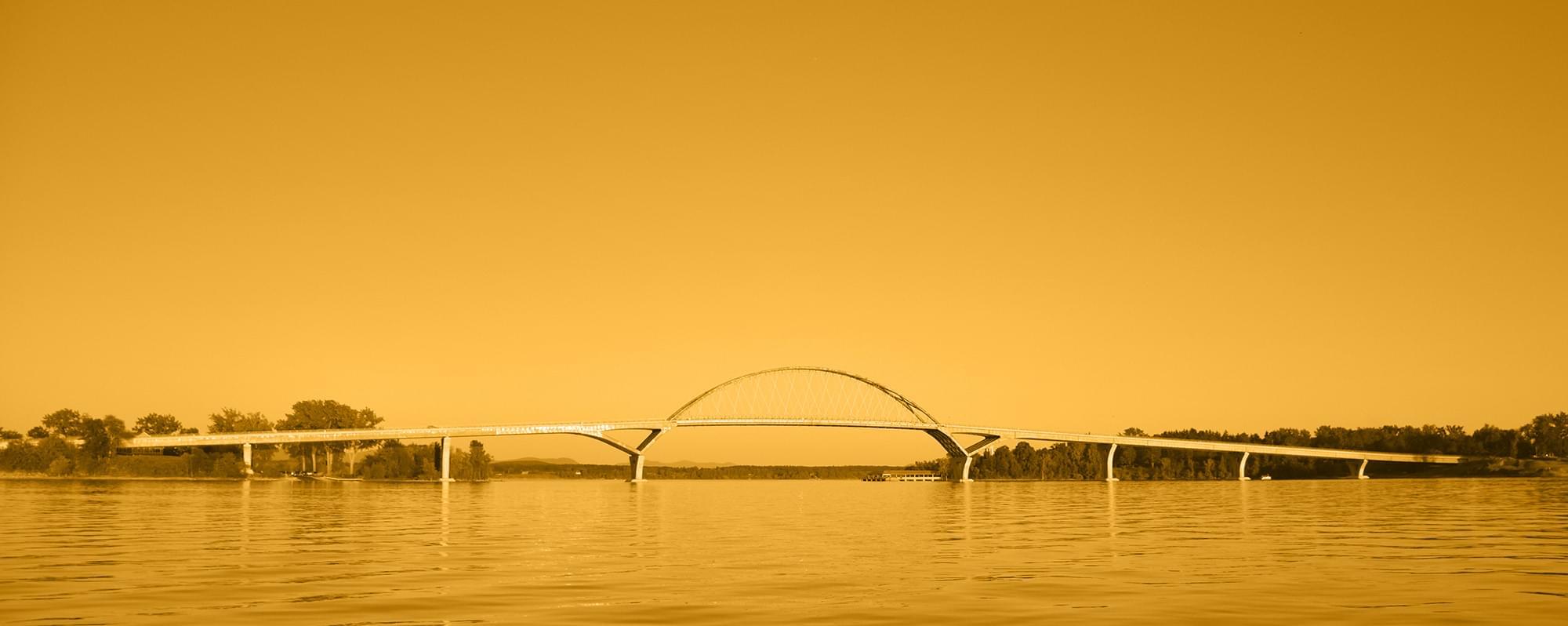
Informed and Involved Public
 GOAL: Basin residents and visitors will understand and appreciate Lake Champlain Basin resources, and will possess a sense of personal responsibility that results in behavioral changes and actions to reduce pollution and support healthy ecosystems and cultural resources.
GOAL: Basin residents and visitors will understand and appreciate Lake Champlain Basin resources, and will possess a sense of personal responsibility that results in behavioral changes and actions to reduce pollution and support healthy ecosystems and cultural resources.
T
he future of the Lake Champlain Basin rests in the hands of its citizens and leaders. For this reason, public information and outreach efforts have been a core function of the LCBP’s work since its establishment. Education and interpretation of cultural and natural heritage have been a central component of the Champlain Valley National Heritage Partnership’s work since its inception in 2006.
The LCBP, the CVNHP, and its partners must continue and expand efforts to engage diverse audiences, including underserved communities, in protecting and appreciating the resources of the entire Basin. Ultimately, a public that understands the Basin’s water quality and resource management problems, with possible solutions, can make informed choices about their role in the protection and restoration of the Lake. Informing the public about how to change personal and collective behaviors and providing opportunities to change those behaviors is critical.
FORMAL LEARNING
Developing this understanding and appreciation at an early age is critical in fostering stewardship of natural and cultural resources. Formal learning in the classroom and field studies that are structured around a curriculum that integrates effective pedagogy and high-quality watershed content equips young citizens to make informed choices about their personal actions exploring the watershed. It also creates a multiplier effect as they share information and values with their parents, families, and other community members.
The LCBP and partners work directly with students through classroom programs and providing first-hand stewardship opportunities, and by training and providing resources to K-12 educators. The Champlain Basin Education Initiative (CBEI), a consortium of environmental and place-based education groups, continues to be a leader in watershed education in the Lake Champlain Basin. Through the Watershed for Every Classroom (WEC) program and annual professional development workshops, CBEI offers rich learning opportunities to teachers so that they might be better equipped to offer them to their students. CBEI has incorporated cultural heritage topics into WEC and its other programs and will work to build this aspect of its offerings going forward.
INFORMAL LEARNING
In addition to formal education efforts, the LCBP will continue to inspire and build awareness among all age groups of watershed issues through informal and less structured outreach. Central to this objective is the need to interpret scientific findings, technical information, and management efforts. The first step to connecting people to the resource and encouraging behavior change is making the science of lake issues understandable to all citizens.
A variety of techniques and forms of media—including face-to-face interpretation and development of exhibits and outreach materials in both print and electronic formats—help to achieve this objective. Mass media outlets such as television and radio can expand the reach of these messaging efforts to the 600,000 Basin residents. The effectiveness of these efforts is enhanced through collaboration with key partners who have similar communications goals and audiences, and who possess skill sets that complement LCBP work.
BEHAVIOR CHANGE AND ACTION
The most successful education and outreach efforts inspire and facilitate citizen action. By making information about lake-friendly products and practices available, and by supporting the efforts of local watershed organizations and other partners to involve the public in direct action, the LCBP can help promote positive stewardship behaviors. New technologies allow citizens to share information and values more quickly and easily than ever before. Employing these tools in social marketing efforts can help engender a shift in collective values around resource stewardship.
Much of the work toward these objectives is accomplished most effectively by local watershed and river groups as well as other nonprofits and communities. As such, support for these organizations is critical to fully implementing this plan. Local implementation grants fund a variety of outreach projects and remain a high priority in the annual budget process.
MEASURES OF SUCCESS
The ultimate outcome of education and outreach efforts is behavior change, but the on-the-ground impacts of specific projects that inform and involve the public can be difficult to determine. Once a program is delivered, the ability to follow up with participants or audiences is limited, particularly over the long term. Some partners have begun to track participants’ behavior change several months after programs, providing a model for short- and mid-term evaluation efforts in the future.
While program-specific evaluations capture participants’ perceptions, immediate actions, and intentions for future behavior, lasting behavior change takes some time to occur. Surveys administered at three- to five-year intervals will help evaluate broad-scale, long-term behavior change and the effectiveness of the strategies and task areas below. Under contract with the LCBP, Lake Champlain Sea Grant has conducted a survey that will serve as a baseline for tracking the public’s knowledge of watershed issues and engagement in stewardship activities. The survey was crafted to reflect on the work of the LCBP and its partners, and it will help guide future outreach efforts of these partners.
Goal-level Metrics:
- Number of education programs offered
- Number of teachers involved in programs and grants
- Number of students reached through those programs and grants
- Number of visitors at the LCBP Resource Room at ECHO
- Number of individuals reached through interpretive and education and outreach programs and presentations
- Number of visitors to LCBP web sites
- Number of volunteers participating in LCBP grant-funded education and outreach projects
Objectives
Support programs that educate stakeholders in formal, organized settings. Provide resources and opportunities for students to increase understanding of and appreciation for natural and cultural resources, related threats, and priority actions needed to address them.
| Strategy | Task Area | Metrics |
|---|---|---|
| IV.A.1: Implement programs for K-12 students. | IV.A.1.a: Fund, Promote, and Deliver School Programs Deliver classroom instruction that increases knowledge of watershed science, recreation, and cultural heritage among K-12 students. |
— Number of students receiving watershed-focused instruction — Number of watershed science, recreation, and cultural programs delivered to K-12 schools — Number of community projects implemented |
| IV.A.1.b: Fund, Promote and Deliver Field Programs Conduct field-based instruction and activities that provide hands-on knowledge of watershed science, recreation, and cultural heritage among K-12 students. |
||
| IV.A.2: Maintain and expand digital/online tools and resources. | IV.A.2.a: Web Outreach Maintain and enhance web resources, update design and content of existing web sites to support digital classroom learning experiences. |
— Number of social media posts — Number of views on LCBP-hosted websites |
| IV.A.2.b: Social Media Amplify social media presence for education efforts. |
||
| IV.A.3: Support professional development for teachers and educator networks. | IV.A.3.a: Professional Development Trainings Deliver, fund, and promote instruction in watershed content and pedagogy for K-12 teachers via CBEI and other workshops. |
— Number of teaching certificate hours awarded — Number of curricula developed |
| IV.A.3.b: Curriculum Development Deliver, fund, and promote resources and curriculum materials developed as part of CBEI workshops and WEC and partner programs |
||
| IV.A.4: Engage youth in watershed management and stewardship opportunities. | IV.A.4.a: Community Service Projects with K-12 students Fund and promote community service projects and mentorship programs focused on clean water and healthy ecosystems, with an emphasis on traditionally underserved communities. |
— Number of youths engaged outside of classroom learning — Number of youth programs implemented |
| IV.A.4.b: Youth advisory committee. Develop and coordinate a group representing youth perspectives across the Basin. |
||
| IV.A.4.c: Youth engagement and exchange opportunities Fund and promote cultural exchanges and international scholarship programs. |
||
| IV.A.4.d: Summer Youth Programs Fund, promote, and deliver summer camp programs focused on hands-on water quality education and conservation practices. |
Develop among residents and visitors an understanding of and appreciation for natural and cultural resources, the related threats, and the priority actions needed to address them.
| IV.B.1: Communicate watershed science and stewardship information for the public and stakeholders. | IV.B.1.a: Report on Condition of the Lake Publish State of the Lake and Ecosystem Indicators Report. |
— Number of workshops, webinars, stakeholder meetings — Number of people engaged in face-to-face or virtual platform meetings or presentations — Number of new outreach publications (print, digital, video) developed — Number of underserved or environmental justice communities engaged |
| IV.B.1.b: Interpretation Develop wayside and interpretive exhibits, brochures, fact sheets, and other print materials that explain natural and cultural resources, including watershed issues and concepts and CVNHP interpretive themes. |
||
| IV.B.1.c: Direct Engagement Deliver face-to-face, small group, and interactive interpretation with members of the public. |
||
| IV.B.1.d: Public Presentations Deliver presentations and demonstrations to inform decision makers, foster public understanding, and inspire action. |
||
| IV.B.1.e: Web/Electronic Outreach Produce video and other dynamic media for LCBP websites and social media. |
||
| IV.B.1.f: Basin Data Sharing Tools Develop, support, and promote digital tools for sharing and interpreting Lake and Basin data, including dashboards, story maps, and portals. |
||
| IV.B.1.g: Print Publications Design and develop print materials to inform public of issues and progress made by stakeholders to address issues. |
||
| IV.B.1.h: Inclusive Outreach Develop targeted outreach and engagement strategies for underserved communities. |
||
| IV.B.1.i: Missisquoi Bay Phosphorus Reduction Support education and outreach programming in collaboration with the Missisquoi Bay Bi-National Phosphorus Reduction Task Force. |
||
| IV.B.1.j: Climate Resilience and Adaptation Deliver, fund, and promote education programs to communicate messaging about climate resilience and adaptation. |
||
| IV.B.1.k: Interpretation through the Arts Deliver, fund, and promote programs that use art to educate and interpret watershed issues. |
Develop programs that enable people to adopt behavioral changes that reflect a personal commitment to protecting and improving resources in the Basin.
| Strategy | Task Area | Metrics |
|---|---|---|
| IV.C.1: Promote individual stewardship action. | IV.C.1.a: Volunteer Opportunities Use web and social media channels to encourage action at home or with local organizations’ volunteer programs. |
— Number of volunteers participating in LCBP or grant-funded programs or projects |
| IV.C.1.b: Outreach materials Promote lake-friendly products and practices. |
||
| IV.C.2: Promote community stewardship action. | IV.C.2.a: Social Marketing Implement social marketing techniques to foster sharing of information and stewardship ethic. |
— Number of communities engaged in watershed programs (e.g. Raise the Blade campaign) — Number of participants in lake leadership programming — Number of participants in volunteer monitoring programs |
| IV.C.2.b: Media Competition Implement a photo/video contest with a content sharing mechanism. |
||
| IV.C.2.c: Leadership Recognition Develop a Lake Leaders program to promote individuals who take steps to improve the health of the Lake. |
||
| IV.C.2.d: Community-based Research Increase community science to engage and develop stewardship for the Basin. |
||
| IV.C.3: Assess changes in the public’s knowledge and behavior. | IV.C.3.a: Public Survey Conduct long-term surveys to track long-term changes in the public’s knowledge and behavior, and effectiveness of LCBP and partner outreach efforts. |
— Number of people demonstrating a minimum level of knowledge or attitude |